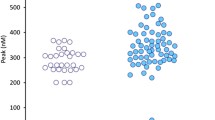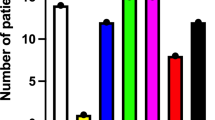Abstract
Activated coagulation and fibrinolytic system in cancer patients is associated with tumor stroma formation and metastasis in different cancer types. The aim of this study is to explore the correlation of blood coagulation assays for various clinicopathologic factors in breast cancer patients. A total of 123 female breast cancer patients were enrolled into the study. All the patients were treatment naïve. Pretreatment blood coagulation tests including PT, APTT, PTA, INR, D-dimer, fibrinogen levels, and platelet counts were evaluated. Median age of diagnosis was 51 years old (range 26–82). Twenty-two percent of the group consisted of metastatic breast cancer patients. The plasma level of all coagulation tests revealed statistically significant difference between patient and control group except for PT (p < 0.001 for all variables except for PT; p = 0.08). Elderly age (>50 years) was associated with higher D-dimer levels (p = 0.003). Metastatic patients exhibited significantly higher D-dimer values when compared with early breast cancer patients (p = 0.049). Advanced tumor stage (T3 and T4) was associated with higher INR (p = 0.05) and lower PTA (p = 0.025). In conclusion, coagulation tests show significant differences in patients with breast cancer.
Similar content being viewed by others
References
Falanga A, Rickles FR. Pathophysiology of the thrombophilic state in the cancer patient. Semin Thromb Haemost. 1999;25:173–82.
Clahsen PC, van de Velde CJ, Julien JP, Floiras JL, Mignolet FY. Thromboembolic complications after perioperative chemotherapy in women with early breast cancer: a European Organization for Research and Treatment of Cancer Breast Cancer Cooperative Group study. J Clin Oncol. 1994;12:1266–71.
Weiss RB, Tormey DC, Holland JF, Weinberg VE. Venous thrombosis during multimodal treatment of primary breast carcinoma. Cancer Treat Rep. 1981;65:677–9.
Brown LF, Guidi AJ, Schnitt SJ, et al. Vascular stroma formation in carcinoma in situ, invasive carcinoma, and metastatic carcinoma of the breast. Clin Cancer Res. 1999;5:1041–56.
Dvorak HF. Thrombosis and cancer. Hum Pathol. 1987;18:275–84.
Miller B, Heilmann L. Hemorheologic variables in breast cancer patients at the time of diagnosis and during treatment. Cancer. 1988;62:350–4.
Ueno T, Toi M, Koike M, Nakamura S, Tominaga T. Tissue factor expression in breast cancer tissues: its correlation with prognosis and plasma concentration. Br J Cancer. 2000;83:164–70.
Falanga A, Levine MN, Consonni E, et al. The effect of very-low-dose warfarin on markers of hypercoagulation in metastatic breast cancer: results from a randomized trial. Thromb Haemost. 1998;79:23–7.
Murray JJ. Coagulation and cancer. Br J Cancer. 1991;64:422–4.
Oya M, Akiyama Y, Yanagida T, Akao S, Ishikawa H. Plasma D-dimer level in patients with colorectal cancer: its role as a tumor marker. Surg Today. 1998;28:373–8.
den Ouden M, Ubachs JMH, Stoot JEGM, van Wersch JWJ. Thrombin-antithrombin III and D-dimer plasma levels with benign or malignant ovarian tumors. Scand J Clin Lab Invest. 1998;58:555–60.
Dirix LY, Salgado R, Weytjens R, et al. Plasma fibrin D-dimer levels correlate with tumour volume, progression rate and survival in patients with metastatic breast cancer. Br J Cancer. 2002;86:389–95.
McCulloch P, Douglas J, Lowe GD, Murray G, George WD. In vivo measurement of fibrin formation and fibrinolysis in operable breast cancer. Thromb Haemost. 1989;61:318–21.
Mitter CG, Zielinski C. Plasma levels of D-dimer: a cross-linked fibrin-degradation product in female breast cancer. J Cancer Res Clin Oncol. 1991;117:259–62.
von Tempelhoff GF, Dietrich M, Hommel G, Heilmann L. Blood coagulation during adjuvant epirubicin/cyclophosphamide chemotherapy in patients with operable breast cancer. J Clin Oncol. 1996;14:2560–8.
Pereira H, Pinder SE, Sibbering DM, et al. Pathological prognostic factors in breast cancer. IV: should you be a typer or grader? A comparative study of two histological prognostic features in operable breast carcinoma. Histopathology. 1995;27:219–26.
Mayer M. Biochemical and biological aspects of the plasminogen activator system. Clin Biochem. 1990;23:197–211.
Schmitt M, Jänicke F, Moniwa N, et al. Tumor-associated urokinase-type plasminogen activator; biological and clinical significance. Biol Chem Hoppe Seyler. 1992;373:611–22.
Zorio E, Gilabert-Estellés J, Espaňa F, et al. Fibrinolysis: the key to new pathogenetic mechanisms. Curr Med Chem. 2008;15:923–9.
Kim HK, Song KS, Lee KR, et al. Comparison of plasma D-dimer and thrombus precursor in patients with operable breast cancer as a potential predictor of metastasis. Blood Coagul Fibrinolysis. 2004;15:9–13.
Oya M, Akiyama Y, Okuyama T, Ishikawa H. High preoperative plasma D-dimer level is associated with advanced tumor stage and short survival after curative resection in patients with colorectal cancer. Jpn J Clin Oncol. 2001;31:388–94.
Taguchi O, Gabazza EC, Yasui H, et al. Prognostic significance of plasma D-dimer levels in patient with lung cancer. Thorax. 1997;52:563–5.
Kirwan CC, McDowell G, McCollum CN, Kumar S, Byrne GJ. Early changes in the haemostatic and procoagulant systems after chemotherapy for breast cancer. Br J Cancer. 2008;99:1000–6.
Batschauer APB, Figueiredo CP, Bueno EC, et al. D-dimer as a possible prognostic marker of operable hormone receptor-negative breast cancer. Ann Oncol. 2010;21:1267–72.
Unsal E, Atalay F, Atikcan S, Yilmaz A. Prognostic significance of haemostatic parameters in patients with lung cancer. Respir Med. 2004;98:93–8.
Rella C, Coviello M, Frenza ND, et al. Plasma D-dimer measurement as a marker of gynecological tumors: comparison with CA 125. Tumori. 1993;79:347–51.
Kilic M, Yoldas O, Keskek M, et al. Prognostic value of plasma D-dimer levels in patients with colorectal cancer. Colorectal Dis. 2008;10:238–41.
Blackwell K, Haroon Z, Broadwater G, et al. Plasma D-dimer levels in operable breast cancer patients correlate with clinical stage and axillary lymph node status. J Clin Oncol. 2000;18:600–8.
Conflicts of interest
None
Role of the funding source
None
Author information
Authors and Affiliations
Corresponding author
Rights and permissions
About this article
Cite this article
Tas, F., Kilic, L. & Duranyildiz, D. Coagulation tests show significant differences in patients with breast cancer. Tumor Biol. 35, 5985–5992 (2014). https://doi.org/10.1007/s13277-014-1793-4
Received:
Accepted:
Published:
Issue Date:
DOI: https://doi.org/10.1007/s13277-014-1793-4




